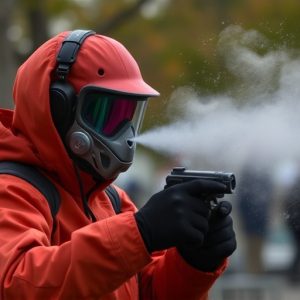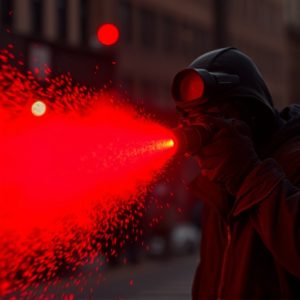Mastering Non-Lethal Defense: The Science and Strategy of Pepper Spray
Pepper spray is an effective non-lethal self-defense tool that causes intense inflammation and pain…….
Pepper spray is an effective non-lethal self-defense tool that causes intense inflammation and pain upon contact with mucous membranes or skin, temporarily incapacitating attackers. Its active ingredient, oleoresin capsaicinoid (OC), derived from chili peppers, creates a burning sensation compelling the eyes to close within seconds. While it does not lead to permanent blindness, the effects are potent and last about 30 to 45 minutes, after which attackers regain normal vision and sensation. Users must be aware of the legal restrictions on pepper spray usage, which vary by jurisdiction, and should receive proper training to ensure its safe handling and deployment. It's important to understand that while pepper spray can temporarily blind an assailant when directly sprayed into their eyes, it is not a tool for misuse or abuse due to its potential effects and the legal implications of using it. Knowledge of its science, limitations, and proper use is essential for anyone considering it as part of their personal defense strategy.
When it comes to personal safety, non-lethal defense options like pepper spray offer a critical line of defense. This article delves into the mechanisms and effects of pepper spray, addressing common questions such as “Can pepper spray blind you?” We explore its scientific impact on vision and its potency, providing insight into its safety considerations. Beyond pepper spray, we examine alternative non-lethal defense options, weighing their pros and cons. Additionally, we navigate the legal landscape surrounding pepper spray use in self-defense to ensure users are informed and prepared. Join us as we shed light on the nuances of non-lethal defense strategies for personal safety.
Understanding Pepper Spray: Mechanisms, Effects, and Safety Considerations
Pepper spray is a non-lethal self-defense tool that has become increasingly popular for its effectiveness in deterring attackers and ensuring personal safety. The substance at the heart of pepper spray is oleoresin capsicum, derived from hot chili peppers, which can cause intense irritation upon contact with the eyes, skin, or respiratory tract. When deployed, it creates an immediate inflammatory response that incapacitates by causing a burning sensation and significant pain, rather than permanently impairing vision as myths might suggest. It’s important to understand that while pepper spray can temporarily blind an attacker by causing them to close their eyes due to the intense pain, it does not have the potential to cause permanent blindness. The effects of pepper spray are typically short-lived, subsiding within 30 to 45 minutes, but they are potent enough to provide a clear advantage in self-defense scenarios. Safety considerations when using pepper spray include understanding its range and wind conditions, as well as knowing the local laws regarding its use. Proper training on how to aim and deploy the spray effectively is crucial to ensure it is used safely and only when necessary for self-defense. Additionally, individuals should be aware of their surroundings and potential risks before choosing this form of defense, ensuring they handle and store it responsibly to prevent accidental exposure or use.
The Science Behind Pepper Spray: How It Affects Vision and Its Potency
Pepper spray, a widely recognized non-lethal self-defense tool, incapacitates assailants by causing intense irritation to the eyes and respiratory system. The active ingredient in pepper spray, oleoresin capsaicinoid (OC), is derived from chili peppers. When deployed, it quickly vaporizes into a cloud of irritant particles. Upon contact with the mucous membranes, including those of the eyes, OC stimulates a cascade of neural responses that culminate in unbearable pain. This response is due to the spray’s interaction with the trigeminal nerves, which are responsible for sensing touch and temperature in the face. The effects are not limited to temporary blindness; victims may also experience coughing, difficulty in breathing, and a significant decrease in their ability to see for about 15 to 45 minutes. The potency of pepper spray is determined by its concentration, which can range from 0.15% to 2% OC. At these concentrations, the effects are so profound that it can indeed lead to temporary blindness, effectively deterring attackers and offering a substantial defense mechanism without causing permanent harm or lethal outcomes. Understanding the science behind pepper spray is crucial for its proper use and appreciation of its effectiveness as a non-lethal means of self-defense. It’s important to note that while pepper spray can temporarily impair vision, it does not possess the potential to cause permanent blindness; this misconception often arises from the intense and immediate impact of the irritant.
Non-Lethal Defense Options Beyond Pepper Spray: Pros and Cons
Non-lethal defense options beyond pepper spray are manifold and each comes with its own set of advantages and disadvantages. For instance, stun guns, also known as electric shock weapons, offer a temporary incapacitation by delivering a high-voltage, low-current electrical charge. This can effectively immobilize an assailant without causing lasting harm. Stun guns are highly effective against individuals who might be under the influence of drugs or alcohol and pose a physical threat. However, their use is contingent on proximity to the target; they must be in close contact for the device to be effective. Additionally, there are concerns regarding the potential escalation of force if not used with restraint.
Another non-lethal defense alternative is the use of impact tools like batons or flashlights designed for self-defense. These can create significant pain without causing permanent injury. They offer a physical barrier and allow for distance between the user and the attacker, which can be critical in de-escalating a potentially violent situation. However, the effectiveness of such tools is largely dependent on the skill and strength of the user, as well as the circumstances of the encounter. Moreover, there are legal considerations to take into account, including the laws governing the use of force in self-defense, which vary by jurisdiction. It’s crucial for individuals to familiarize themselves with local regulations before relying on these devices for their safety. Understanding the pros and cons of each non-lethal defense option can help potential users make informed decisions tailored to their specific needs and circumstances.
Legal Implications and Best Practices for Using Pepper Spray in Self-Defense
When considering non-lethal defense options, pepper spray emerges as a prevalent choice for personal safety due to its effectiveness in deterring attackers. Its ability to incapacitate assailants temporarily through oleoresin capsicin, an irritant that causes extreme discomfort upon contact with mucous membranes, is well-documented. However, the legal implications of using pepper spray in self-defense vary by jurisdiction. Users must familiarize themselves with local laws, as some regions have specific restrictions on the purchase, carrying, and use of pepper spray. For instance, there are regulations on the strength of the spray allowed and where it can be legally used. It is crucial to understand that while pepper spray is considered non-lethal, its impact can be significant, potentially leading to temporary blindness if sprayed directly into a person’s eyes. Consequently, best practices for using pepper spray responsibly emphasize aiming low towards the face or upper body of an attacker, ensuring proper ventilation to avoid inhalation, and only employing it when there is an imminent threat of harm. Training on the correct usage can also mitigate misuse and legal complications. Users should also be aware that law enforcement may view the use of pepper spray from civilians differently than in a self-defense class setting, so it is imperative to act within the bounds of the law and use this tool as a last resort. Adhering to these guidelines not only ensures personal safety but also helps maintain legal standing and avoid unintended consequences that could arise from misuse or unawareness of local regulations.


